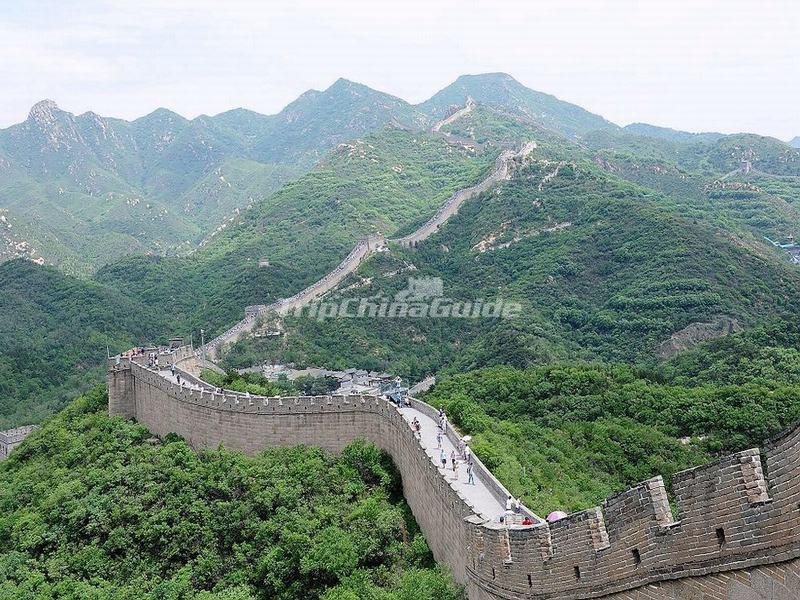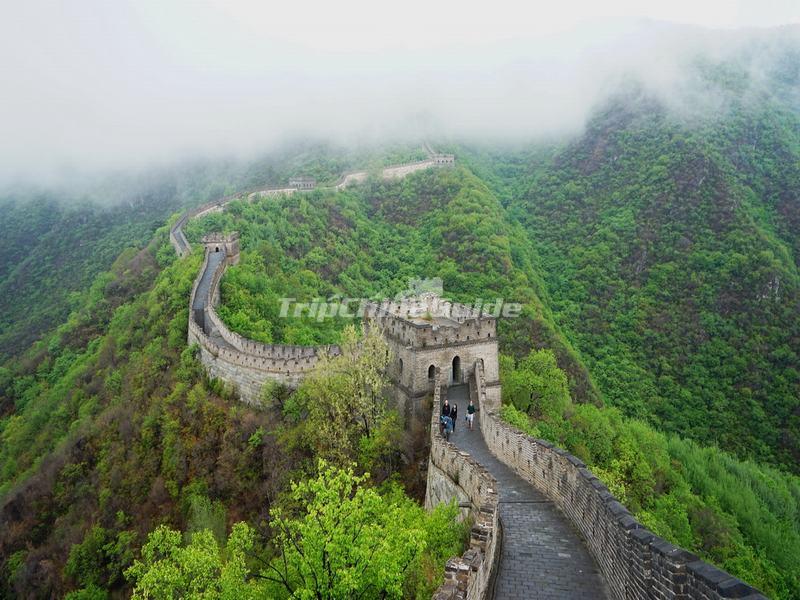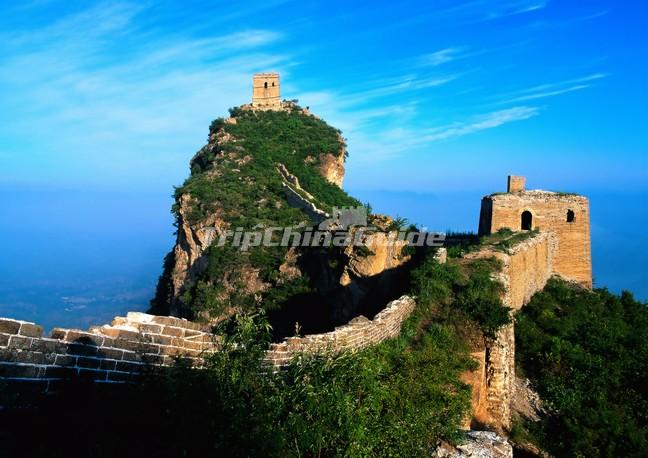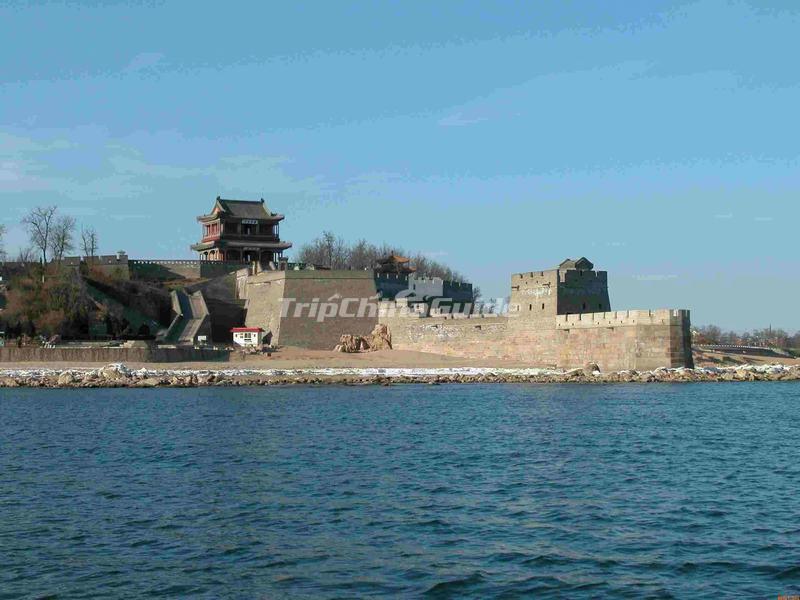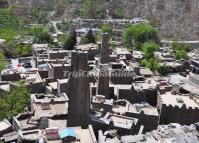The Great Wall
The Great Wall is 6,700 km in length, running east to west and crossing five provinces. Appearing as a long, serpentine dragon, it winds across lands including deserts, grasslands and even mountains. Every type of material available at the time was used, from mud and reeds, to the finest mortar bricks ever made.
The history of the Great Wall spans more than 2000 years, and it is now considered to be one of the greatest wonders on earth. Though there are sections of the wall that have now fallen into ruin, or that have even completely disappeared, it remains one of the most south attractions in the entire world due to its majesty as well as its great significance. In 1987, UNESCO listed the Great Wall of China among the prestigious World Heritage Sites.
History of the Great Wall
Though it is not known exactly when the construction of the Great Wall of China began, it is commonly believed that it was built as a military fortification to protect against tribal intrusions across the borders during the Zhou Dynasty. In the late Spring and Autumn Period (770 B.C. – 476 B.C.), the ducal states extended their defense works and began building “great” structures for prevention of attacks from neighboring states.
In 221 B.C. after conquering most of its neighboring states, Ying Zheng, the ruler of the Qin State declared himself Qin Shi Huang, the first Emperor of the Qin Dynasty. Thus began the reign of the First Emperor of China and the beginning of the Great Wall. Qin Shi Huang began the construction of the Great Wall by connecting many of the existing border walls to protect the northern border of his kingdom from invasion. The construction continued for centuries and employed the work of millions.
It took about ten years to finish and the wall stretched from Lintao (in the eastern part of today’s Gansu Province) in the west to Liaodong (in today’s Liaoning Province) in the east.
The wall not only provided incredible defense in the north of the country, but was a tremendous symbol of the emperor’s might.
After the Qin Dynasty, the Great Wall experienced many extensions. Emperor Wu (Han Wu Di) of the Han Dynasty wished to maintain safety against the Xiongnu, as they had been at war with this tribe in 127 B.C., 121 B.C. and 119 B.C., so he extended the wall to the west to guard the Hexi Corridor (now the Gansu Province) as well as the Xinjiang region.
Later, many more constructions and extensions were made to the great wall within the successive Northen Wei, Northern Qi and Sui dynasties.
Presently, the Great Wall that exists in Beijing is from the Ming Dynasty (1368 – 1644). It was built from bricks and granite and included greatly sophisticated designs and passes, holding largely strategic importance. The Ming Wall begins from Yalujiang River (which lies in today’s Liaoning Province) and stretches over 5,000 km to Gansu.
Today, the Wall has become a must-see for every visitor to China. Few can help saying “Wow!” when they stand on the top of a beacon tower and look at this giant dragon. For centuries, the wall served succeeding dynasties as an efficient military defense. However, it was only when a dynasty had weakened from within that invaders from the north were able to advance and conquer. Both the Mongols (Yuan Dynasty, 1271–1368) and the Manchurians (Qing Dyansty, 1644 –1911) were able to take power because of weakness of the government and poverty of the people but never due to any possibility of weakness of the Wall.
Legends and Stories of the Great Wall
Lots of beautiful legends and stories about the Great Wall took place following along the construction, and since that time these stories have spread around the country. Those that happened during construction are abundant, such as Meng Jiangnu's story and the legend of the Jiayuguan Pass. Meng Jiangnu's story is the most famous and widely spread of all the legends about the Great Wall. The story happened during the Qin Dynasty (221BC-206BC). It tells of how Meng Jiangnu's bitter weeping made a section of the Great Wall collapse. Meng Jiangnu's husband Fan Qiliang was caught by federal officials and sent to build the Great Wall. Meng Jiangnu heard nothing from him after his departure, so she set out to look for him. Unfortunately, by the time she reached the great wall, she discovered that her husband had already died. Hearing the bad news, she cried her heart out. Her howl caused the collapse of a part of the Great Wall. This story indicates that the Great Wall is the production of tens of thousands of Chinese commoners.
Another legend about the Jiayuguan Pass tells of a workman named Yi Kaizhan in the Ming Dynasty (1368BC-1644BC) who was proficient in arithmetic. He calculated that it would need 99,999 bricks to build the Jiayuguan Pass. The supervisor did not believe him and said if they miscalculated by even one brick, then all the workmen would be punished to do hard work for three years. After the completion of the project, one brick was left behind the Xiwong city gate. The supervisor was happy at the sight of the brick and ready to punish them. However Yi Kaizhan said with deliberation that the brick was put there by a supernatural being to fix the wall. A tiny move would cause the collapse of the wall. Therefore the brick was kept there and never moved. It can still be found there today on the tower of the Jiayuguan Pass.
In addition to the above-mentioned stories about the construction of the Great Wall, there are also plenty of stories about current scenic spots. A famous one is the legend of the Beacon Tower. This story happened during the Western Zhou Dynasty (11th century BC-711 BC). King You had a queen named Bao Si, who was very pretty. King You liked her very much, however Bao Si never smiled. An official gave a suggestion that setting the beacon tower on fire would frighten the King's subjects, and might make the queen smile. King You liked the idea. The subjects were fooled and Bao Si smiled at the sight of the chaos. Later enemies invaded Western Zhou, King You set the beacon tower on fire to ask for help. No subjects came to help because they had been fooled once before. Thus, King Zhou was killed by the enemy and Western Zhou came to an end.
Some Famous Sections of the Great Wall
1) Badaling Great Wall
Construction of Badaling in Yanqing County, Beijing, started in the Ming Dyansty (1368 – 1644) and underwent 18 rebuilt from the Hongwu to the Wanli reign (1368 – 1620). Badaling leads to Beijing in the south, Yanqing in the north, Xuanhua and Datong in the west. Hence the name Bada means reaching out in all directions. The wall, built with huge stone slabs on the outside, is 7.8 meters high on the average and 5.8 – 6.5 meters wide. The crenellated wall has parapets; and watchtowers and fighting platforms are built in 1050(the 18th year of the Ming HOngzhi reign). The best preserved section of the Great Wall, Badaling located at a very important position and has a beautiful surrounding scenery and its structures show a special grandeur.
2) Mutianyu Great Wall
Lies in Huairou County,the Mutianyu Great Wall is 73 kilometers away from Beijing City. It links with Juyong Guang Pass Great Wall in Changping County in the west and Gubeikou Great Wall in Miyun County in the east. Commanding the strategic importance, Mutianyu Section is called as the Majestic Pass on Precipitous Mountains. It is integrated with Juyong Guan Pass Great Wall and Frontier Fort, and constitutes a complete defensive system. It is one of the best-preserved parts of the Great Wall.
Due to its relatively gentle terrain, watchtowers of Mutianyu Section were built in large numbers to strengthen its defensive functions. The closest watchtowers spaced less than 50 meters apart. Both arms of Mutianyu Section stretch upwards along the ridges of continuous mountains. Mainly built on precipitous mountains and 5 -7 meters high, the Mutianyu Great Wall we see today is expanded on the foundation of the Ming Dynasty’s Great Wall. It is characterized with a thick cluster of watchtowers atop, strategic passes, majestic vigor and unique structure. The gate tower is the most unique building of Mutianyu Great Wall.
3) Simatai Great Wall
Located on the boundary of Gubeikou Town, Miyun County, Beijing, and Luanping County, Hebei Province, the 19 kilometer Simatai Great Wall began in the first year of the Hongwu Reign of the Ming Dynasty. The design and construction of this section of the Great Wall are exquisite and striking. Every one of the 35 watchtowers is original and different. The tower for Viewing the Capital, 986 meters above the sea level is, is constructed on sheer precipices, commanding a panoramic view of "snow-capped Wuling" in the west, a “mirror-like reservoir” in the south and “verdurous Yanshan Mountain: in the north. Just as outstanding are the natural sceneries at Heavenly Ladder, Fairy Bridge, Heavenly Pool and the Spring of Mandarin Duck and Drake which compliment the scenes of the man-made Great Wall.
4) Jiankou Great Wall
Situated in the mountain ridge of Xizhazi Village, about 30km (19 miles) to Huairou County in Beijing, Jiankou Great Wall was a vital area of the wall in Ming Dynasty (1368 - 1644). Owing towards the need for renovation, the wall is regarded as one of most unsafe sections of the Ming's wall. The key area in the wall was constructed along the ridges with steep cliffs on each and every side. Therefore, it's important to prepare for a great fitness and great care if you climb this area.
The wall connects to Mutianyu in the east and joins Huanghuacheng in the west. From east to north, the wall zigzags 9.3 miles from "The Ox Horn Edge Wall" to "The Nine-Eye Tower" through "The Beijing Knot". Compared with Mutianyu Great Wall, the mountain is greater and steeper, while compared with Simatai Great Wall it is much more winding and varied. The Jiankou Great Wall was created from the regional materials - dolomite. The significant pieces of white rock make the wall striking towards the eye at a distance.
5) Juyongguan Pass Great Wall
Juyongguan Pass Great Wall lies to the northwest of Changping County, Beijing. The tern Juyong, appearing first in The Spring and Autumn Annals of Mr Lu of the Warring States Period, was attached to this pass during Qin Shi Huang's time. In the Han Dynasty it was called Juyongguan, in the Three Kingdongs' Period the West Pass, in Northern Qi, the Tax Pass, in the Tang Dynasty Juyongguan Pass, Jimen Pass or Jundu Pass. All through Liao, Kin, Yuan, Ming and Qing dynasties to the present day it has been called Juyongguan.
The castle of this important pass of the Great Wall was built in 1368 (the beginning of the Reign of Hongwu in the Ming Dynasty) to found the Ming Dynasty. It has been renovated many times afterwards.
5) Shuiguan Great Wall
Shuiguan (Water Pass), which was first built in the Ming Dynasty, was an indispensable part of the defense system of Badaling Great Wall. The pass mainly functioned to defend against invaders by the force of torrential water following through between the two mountains. It is one of the best preserved section of the Great Wall of China, which stretches and an arrow tower which is 15 meters in height and 12 meters in width. Looking out from the arrow tower, you can imagine an ancient battle fields and see the importance of the wall as a defense against invaders.
6) Gubeikou Great Wall
This section of Great Wall is located in Gubeikou Township, Miyun County, Beijing. Very dangerous in geological sense, it controls the important passage from Beijing to frontier plateaus. Its wall links up Mt. Dragon and Mt. Tiger into a powerful defense. The section was the wall of State of Yan in Warring States Period, and many well known battles fought here. In 1379, General Xu Da of the Ming Dyansty rebuilt the section and named it Ying City, but only some remains of it are still there now. On the south slope of Gubeikou is a shrine for the well respected General Yang Ye of the Northern Song Dynasty.
7) Huangyaguan Great Wall
Located in the mountainous area of Tianjin's northern Ji County, the Huangyaguan Great Wall was first built during the Northern Qi Dynasty (550 - 557) and repaired in large scale with bricks during the Ming Dynasty (1368 - 1644). When appointed as the chief commanding officer in the Ji Garrison (one of the eleven garrisons of the Ming Dynasty), Qi Jiguang added watch towers and other defensive works. The Huangyaguan Great Wall comes out first in the ten most-visited sites in Tianjin. It is considered to be a miniature of the Great Wall. The entire section is built on an abrupt mountain ridge. Being endowed with both natural beauty and cultural interest, it has become famous as a natural beauty spot and a summer resort. The major scenic area is composed of Huangyaguan Pass and Taiping Mountain Stronghold. Huangyaguan Pass: In 1984, the people of Tianjin spent three years repairing 3,308 yards of the main wall from Banlagang Mountain in the east to Wangmaoding Mountain in the west. They restored 20 terraces, the Huangyaguan Water Gate, and the Bagua Castle (the Eight Diagrams Castle). The defensive system of the wall is complete. Watch towers, frontier cities, drain holes, emplacements, barracks and other indispensable military facilities are arranged orderly along the wall. Besides, the stele forests of the Great Wall, Beiji Temple, the exhibition hall of famous couplets, the Great Wall Museum (the first museum along the Great Wall) and the Phoenix Fortress have been newly built within the area. Taipingzhai Great Wall: Six miles southeast of Huangyaguan Pass is the Taipingzhai Great Wall, another important mountain stronghold of the wall during the Ming Dynasty (1368 - 1644). It is also called Taipinganzhai, meaning "a village of peace and prosperity". Starting from Banlagang Mountain in the east and arriving at Guafu Tower (Widow Tower) in the west, it winds through the precipitous mountains for about 955 yards. The wall is an important component of Huangyaguan Great Wall. There are six watch towers, one battlement, and one shortcut leading to the wall. The architectural styles of the military towers vary considerably. There are square, round, solid and hollow towers, with some inside and others outside the wall. Beside the shortcut, there is a small citadel where an 8.5-meter statue of Qi Jiguang, the chief commanding officer of Ji Garrison (one of the eleven garrisons in the Ming Dynasty) is located. The local people built this statue in order to commemorate his great contribution to frontier peace and stability in that period. To the west of the citadel, a section of the wall extends 33 yards out to where a sentry post was situated. At the western end of the wall is a square stone tower called Guafu Tower, "Widow Tower" in English, built by twelve wives whose husbands died during the construction of the wall in the Ming Dynasty. The widows erected this tower to commemorate their husbands' notable exploits. The tower has two levels and measures 13-meters (14-yards) high. Arched arrow windows are on the four sides of the tower.Besides these cultural points of interest, Taipingzhai Great Wall is also famous for its amazingly impressive scenery. Zigzagging along the mountain ridge for over 984 yards, the wall looks very much like a giant dragon flying through clouds.
8) Shanhaiguan Pass Great Wall
Located on the shore of the Bohai Sea about 4 kilometers away from the city of Shanhaiguan, the Shanhaiguan Pass Great Wall (aka Laolongtou Great Wall) is the starting point of the Ming Dynasty Great Wall. Set against the mountain and facing the sea, the 11 meters high wall was constructed with stones at its base, with a section of about 25 meters extending down to the sea. It is called "The Stone Wall Entering the sea" and was built by Qijiguang. Commander of the garrison troops at Jizhen in the Ming Dynasty. The huge stone wall looks like a dragon's head poking into the est sea head Laolongtou consists of the wall extending to the sea. Jinglutai, Nanhaikouguan and Chenghailou. The tower of Chenghailou was first built in the Ming Dynasty and rebuilt during the Kangxi and Qianlong Periods of the Qing. Hung on it are two horizontal boards. One of which has inscriptions written by Sun Chengzong, a high official of the Ming and the other with inscriptions by Emperor Qianlong of the Qing Dyansty. On the wall of the building are inlaid several stone tablets with inscriptions written by famous people of past dynasties .On the southern side of the tower is a huge stone tablet with four characters carved on it. At Laolongtou one can enjoy a panoramic view of the vast sky, the boundless surging sea and the magnificent ranging mountains.








